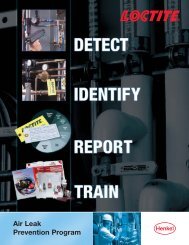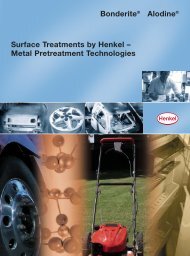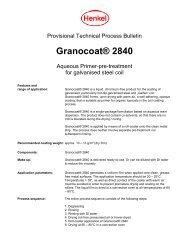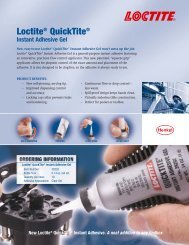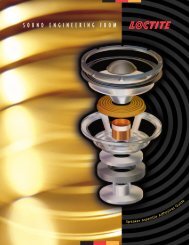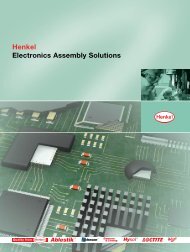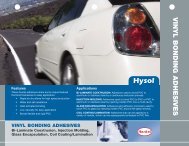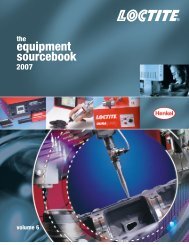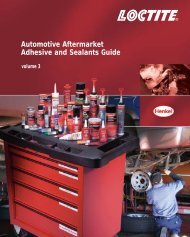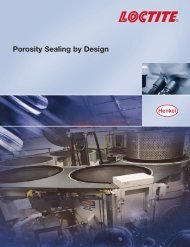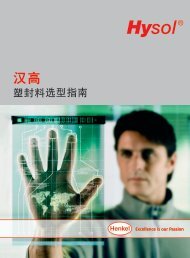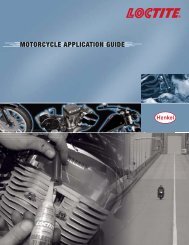Tightening Up Type 4 - Henkel
Tightening Up Type 4 - Henkel
Tightening Up Type 4 - Henkel
- No tags were found...
You also want an ePaper? Increase the reach of your titles
YUMPU automatically turns print PDFs into web optimized ePapers that Google loves.
<strong>Tightening</strong> <strong>Up</strong> <strong>Type</strong> 4by Richard Boyle, Neil Poole and Brian Toleno<strong>Henkel</strong> CorporationThough the majority of assemblers are using <strong>Type</strong> 3 solder paste for most of today’smainstream applications, the prevalence of finer-pitched devices is growing. With01005s and 0.3mm CSPs showing up in more and more assemblies, use of <strong>Type</strong> 4solder paste will soon rival that of <strong>Type</strong> 3. The thinner stencils and smaller aperturesizes required to address fine-pitch devices dictate the use of solder paste with finerpowder particle sizes – without it, variable and decreasing print volumes in addition topoor release from the stencil will likely be the result.But, what is the standard for particle size in <strong>Type</strong> 4 materials? When pitches wererelatively generous by comparison to today’s miniaturized components, a solder paste’sparticle range distribution and particle size wasn’t as critical. Today, nothing could befurther from the truth. Unfortunately, the current standard is a bit ambiguous as to whatis or isn’t allowed as far as size in the upper end of the particle range for <strong>Type</strong> 4 pastes.Though the current IPC standard J-STD-006A (2001) allows for a broad distributionrange of particle sizes (Figure 1), <strong>Henkel</strong> has decided to push beyond that based on ourbelief that a tighter distribution range and a smaller upper limit particle size will preventproblems down the line.Powdertype< 0.005wt% greaterthan
as pristine as possible is very important as smaller particle sizes are incorporated intopaste materials. <strong>Henkel</strong>’s powder production methodology allows for consistent, smoothparticles – even at sub-35 micron sizes.While the official standard for <strong>Type</strong> 4 particle sizes is currently being scrutinized, <strong>Henkel</strong>has developed our own criteria internally to address what we consider to beshortcomings of the current standard. <strong>Henkel</strong> believes that today’s standard allows fortoo many oversized particles and too many undersized particles. By our estimates, thevariance of particle sizes in a batch of today’s standard <strong>Type</strong> 4 solder paste could rangeanywhere from 5 microns up to 50 microns. <strong>Henkel</strong> thinks that’s not ideal. It is veryeasy for a single oversized particle to become trapped in an aperture, resulting inmultiple insufficients for that particular pad type and quite a large defect rate. Bytightening up the particle size limit and acceptable distribution, <strong>Henkel</strong>’s Multicore DAPPlus has alleviated this problem and afforded robust, high-speed production for fine-pitchassemblies.As the industry forges ahead with ever-smaller device designs and production, the needfor capable solder paste materials will be even greater. For example, customers arealready talking about 0.3mm CSPs, printing through 80 micron thick stencils withaperture sizes of 150 microns. With dimensions like this, it is easy to understand how a50 micron powder particle could easily block an aperture and why <strong>Henkel</strong> is confidentthat a fine-tuning of the current specification is warranted. In fact, our own studies haveproven as much. (See Figure 2).25002000Failure Rate / ppm150010005000CompetitionSolder Paste<strong>Henkel</strong>Figure 2: Solder paste formulated with Multicore DAP Plus <strong>Type</strong> 4 powder versus competitive<strong>Type</strong> 4 solder paste exhibits significantly lower failure rates.
The bottom line is that, just as with many other materials, all <strong>Type</strong> 4 solder pastes arenot created equal and performance from one to another can vary wildly. <strong>Henkel</strong>considers it our responsibility to manufacture the most robust, highest performingmaterials available – ensuring excellent results and a low-risk partnership proposition forour customers. This has been and continues to drive our product development initiativesand, in the case of <strong>Type</strong> 4 solders, is why we have tightened up our own standards,regardless of what other suppliers are doing.For more information on Multicore DAP Plus solder powder and our advanced line oflead-free solder pastes, please call the <strong>Henkel</strong> headquarters at 949-789-2500 or logonto www.henkel.com/electronics.



